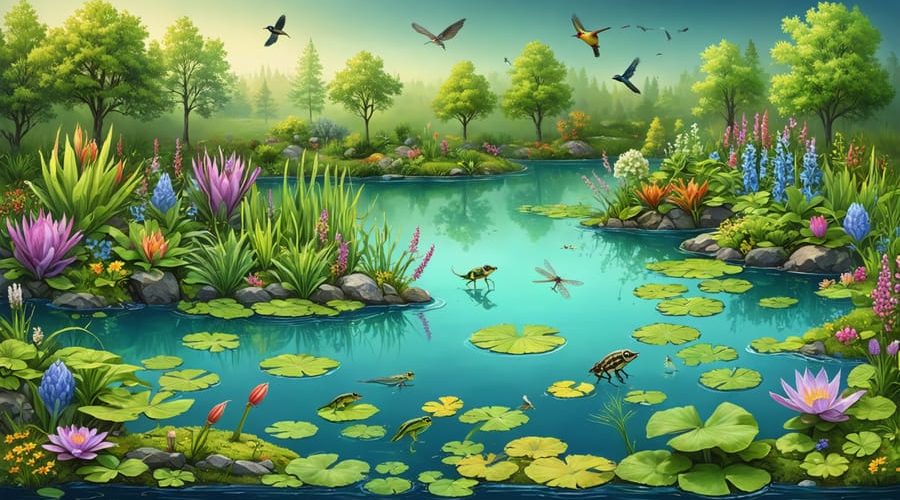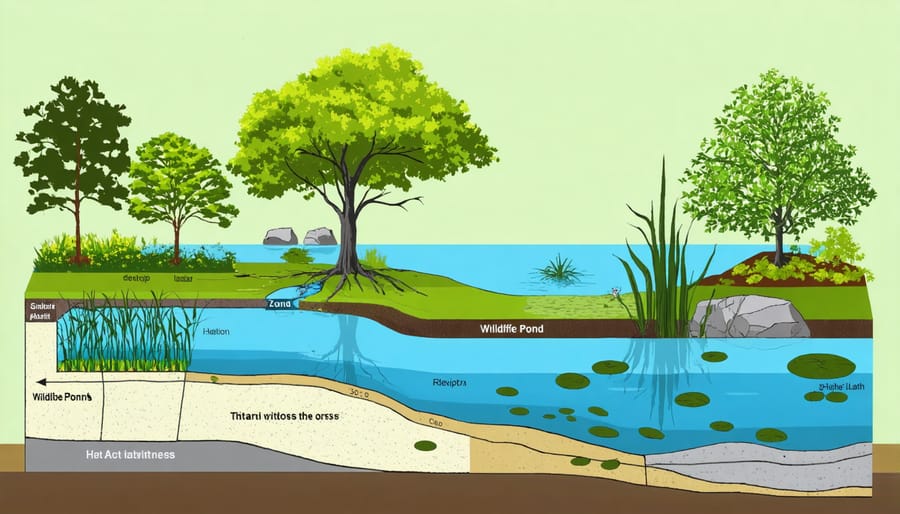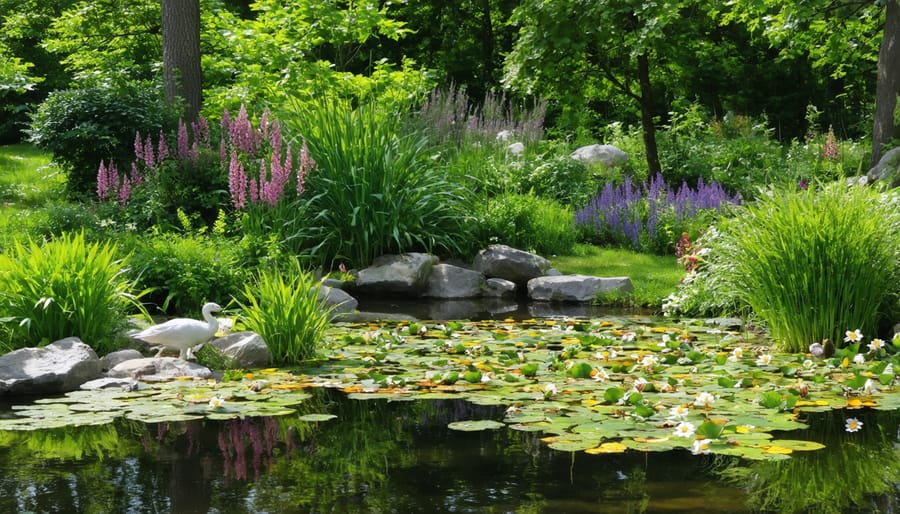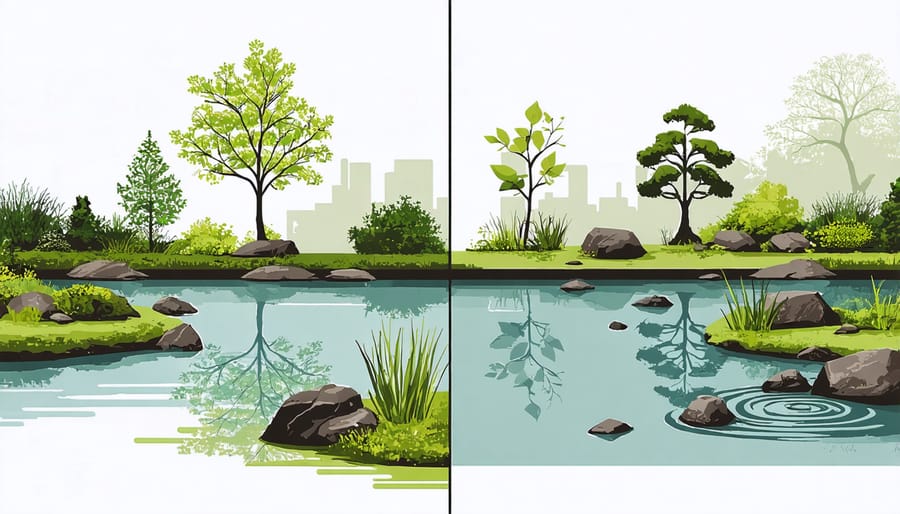
How Your Pond Can Fight Climate Change (While Boosting Wildlife)
Climate change poses an unprecedented threat to Earth’s biodiversity, fundamentally altering ecosystems and pushing countless species to the brink of extinction. As global temperatures rise and weather patterns become increasingly erratic, the delicate web of life that sustains our planet faces mounting pressure. From melting polar ice caps to disappearing rainforests, the impacts ripple through every habitat, disrupting age-old relationships between species and testing nature’s ability to adapt.
Yet within this challenge lies an opportunity for positive action. By understanding how biodiversity responds to climate change, we can develop targeted conservation strategies that protect vulnerable species while building more resilient ecosystems. Communities worldwide are already pioneering innovative approaches – from creating wildlife corridors that allow species migration to restoring wetlands that buffer against extreme weather events.
This interconnected crisis demands an interconnected solution. As we work to reduce greenhouse gas emissions and slow global warming, we must simultaneously strengthen nature’s capacity to withstand change. The preservation of biodiversity isn’t just about saving individual species – it’s about maintaining the complex ecological relationships that help our planet regulate climate, produce food, filter water, and sustain life itself.
By bringing these two crucial environmental challenges together, we can forge solutions that address both biodiversity loss and climate change, creating a more sustainable future for all living things.
Why Climate-Resilient Ponds Matter Now
Your Pond as a Wildlife Haven
A well-designed pond is more than just a water feature – it’s a thriving ecosystem that supports countless species. Even a small garden pond can become a vital refuge for local wildlife, especially as natural habitats face increasing pressure from climate change.
Your pond creates different microhabitats within its various depths and zones. The shallow margins provide drinking spots for birds and hedgehogs, while deeper areas offer safe havens for amphibians. Aquatic plants not only add beauty but also provide shelter and breeding grounds for insects like dragonflies and damselflies.
The surrounding vegetation is equally important, creating corridors that allow wildlife to move safely between different areas. By including a mix of native plants around your pond, you’ll attract pollinators and provide food sources for various creatures throughout the seasons.
To maximize biodiversity, include features like partially submerged logs, rock piles, and gently sloping sides. These elements create additional microhabitats and ensure safe access for all pond visitors. Remember, even the smallest pond can make a significant difference in supporting local wildlife populations during challenging climate conditions.
Climate Change Challenges for Pond Life
Climate change is posing several significant challenges for pond ecosystems. Rising temperatures cause increased water evaporation, leading to lower water levels and potentially stressing aquatic plants and animals. When ponds become shallower, they heat up more quickly, reducing oxygen levels that fish and other pond life need to survive.
Erratic weather patterns bring both extended dry spells and intense rainfall events. During droughts, ponds may shrink dramatically or dry up completely, while heavy rains can overwhelm pond systems, washing away plants and disturbing habitats. These extreme conditions make it harder for pond wildlife to establish stable communities.
Changes in seasonal timing also affect pond life cycles. Earlier spring warmth might trigger premature breeding in amphibians, while late frosts can damage emerging plants and spawning areas. Some pond species struggle to adapt to these shifting patterns, while others may disappear entirely from areas they once called home.
Algae blooms become more common in warmer conditions, particularly when combined with nutrient runoff from heavy rains. This can reduce water quality and create challenging conditions for fish and other aquatic creatures.
Creating a Climate-Smart Pond Design
Depth Zones for Temperature Control
Creating varying depths in your pond isn’t just about aesthetics – it’s a clever strategy for maintaining stable temperatures in our changing climate. Think of your pond as a natural refrigerator with different temperature zones that help protect your aquatic friends during extreme weather.
The deepest zone, ideally at least 6 feet deep, acts as a thermal refuge where fish can retreat during both hot summers and cold winters. This zone maintains a relatively constant temperature year-round, typically around 39-45°F (4-7°C), providing a safe haven for your pond inhabitants.
The middle zone, ranging from 2-4 feet deep, creates a transitional area where temperature fluctuations are moderate. This zone is perfect for many aquatic plants and allows fish to adjust gradually as they move between depth levels.
The shallow zone, typically 6-12 inches deep, while more susceptible to temperature changes, serves an important purpose. It provides essential spawning areas for fish and supports marginal plants that help shade and cool the water.
To maximize temperature control:
– Position deeper areas away from direct afternoon sun
– Include overhanging plants for natural shade
– Consider adding a fountain or waterfall to maintain water movement
– Install shelves or ledges at different levels for easy plant placement
– Use rocks and gravel to help regulate temperature changes
Remember, these zones work together as a natural temperature management system, helping your pond maintain biodiversity even as our climate continues to change. The key is creating a balanced mix of depths that provides options for all your pond’s inhabitants.

Plant Shelves and Safe Havens
Creating safe spaces for wildlife during extreme weather events is becoming increasingly important as our climate changes. Start by incorporating different levels of plant shelves in your pond – shallow areas for marginal plants, mid-depth zones for submerged vegetation, and deeper sections that provide refuge during both heat waves and cold snaps.
Consider building rock piles or log stacks near your pond’s edge. These natural structures create microhabitats that shelter small creatures during harsh conditions. Position them partially in the water and partially on land to accommodate both aquatic and terrestrial wildlife.
Dense plantings around your pond’s perimeter act as windbreaks and provide essential cover. Layer your plantings with tall grasses, medium-height perennials, and ground covers to create a diverse habitat structure. Native plants are particularly valuable as they’re already adapted to local conditions and provide familiar shelter for native wildlife.
Include floating plants like water lilies, which offer shade during hot spells and hiding spots for fish and amphibians. In winter, these same plants protect the water below from freezing solid. Consider installing a small island or floating platform that wildlife can use as a retreat during floods or when predators are nearby.
Remember to maintain some open areas too – wildlife needs easy access to move between different zones. During pond maintenance, avoid removing all plant debris at once; instead, work in sections to ensure some protective cover remains available at all times. These thoughtful design elements will help create a resilient ecosystem that supports biodiversity throughout changing weather patterns.
Choosing Climate-Hardy Plants and Fish

Native Plants That Beat the Heat
As our climate continues to change, choosing the right native plants can make all the difference in creating a resilient garden ecosystem. Native plants that have evolved in your local area are naturally equipped to handle weather extremes and provide essential habitat for local wildlife.
For sunny, drought-prone areas, consider tough natives like Black-Eyed Susans and Purple Coneflowers. These beautiful blooms not only attract pollinators but also develop deep root systems that help them survive hot, dry spells. Prairie grasses like Little Bluestem and Switch Grass are excellent choices that provide year-round interest and can handle both flooding and drought conditions.
In water garden margins, native moisture-lovers like Blue Flag Iris and Cardinal Flower thrive while providing nectar for hummingbirds and butterflies. These plants help filter water and prevent erosion, making them perfect companions for your pond ecosystem.
For shaded areas, try native ferns and woodland plants like Wild Ginger or Solomon’s Seal. These shade-lovers are surprisingly resilient and help create cooling microhabitats that benefit other plants and wildlife.
When selecting plants, look for species native to your specific region. Local native plant nurseries can help you choose varieties that will thrive in your particular conditions. Remember to group plants with similar water needs together and mulch well to retain moisture. With the right native plants in place, your garden can become a climate-resilient haven for local biodiversity.
Fish Species for Changing Conditions
When selecting fish for your climate-resilient pond, certain species adapt well to temperature fluctuations and make excellent choices for changing conditions. The hardy Goldfish is a perfect starter fish, particularly the Common and Comet varieties, which can handle temperatures between 4°C and 30°C. These friendly swimmers are also relatively low-maintenance and great for beginners.
Koi carp are another fantastic option, known for their resilience and ability to withstand varying water conditions. While they require more space and care than goldfish, their striking colors and personalities make them worth the extra effort. Just remember to provide adequate depth (at least 1.5 meters) to help them cope with temperature extremes.
For smaller ponds, consider White Cloud Mountain Minnows, which naturally inhabit mountain streams and can handle both cool and warm waters. These active little fish add movement and life to your pond while helping control mosquito larvae.
Weather Loaches are excellent environmental indicators and can sense approaching weather changes. They’re perfect for variable climates and can survive in temperatures ranging from 2°C to 28°C. Plus, their bottom-feeding habits help keep your pond clean.
When introducing any fish, remember to acclimate them slowly and avoid overcrowding, as this helps maintain water quality during extreme weather events.
Simple Maintenance for Maximum Wildlife Impact
Seasonal Care for Wildlife Protection
As seasons shift due to climate change, supporting local wildlife requires thoughtful year-round care. In spring, leave early-blooming flowers undisturbed and maintain shallow water sources for emerging pollinators. Consider installing nesting boxes and creating brush piles from fallen branches to provide shelter for breeding birds and small mammals.
Summer brings increased temperatures and potential drought. Keep water features filled and clean, adding floating logs or rocks as landing spots for insects and birds. Plant native species that provide natural shade and food sources, and avoid trimming vegetation during peak nesting periods.
During fall, resist the urge to clear all fallen leaves – they provide essential shelter for hibernating insects and small creatures. Leave seed heads on flowers and maintain berry-producing shrubs to provide vital food sources during migration periods.
Winter care focuses on shelter and food accessibility. Create windbreaks with evergreen plantings, maintain unfrozen water sources using solar-powered heaters, and continue providing food through bird feeders positioned near protective cover. Leave standing dead plants and hollow stems intact as they serve as winter homes for beneficial insects.
Remember that consistency in these seasonal practices helps wildlife adapt to changing climate patterns. Monitor your garden’s wildlife activity and adjust your care routine based on observed needs and local weather conditions.

Water Quality in a Changing Climate
Climate change poses significant challenges for managing water quality in our ponds, but with the right approach, we can maintain healthy ecosystems for diverse aquatic life. Rising temperatures and irregular rainfall patterns affect oxygen levels, nutrient balance, and overall water chemistry, making it crucial to adapt our maintenance routines.
To keep your pond thriving, start by monitoring temperature fluctuations regularly. When temperatures rise, consider adding an aerator or fountain to boost oxygen levels – your fish and plant life will thank you! Installing shade sails or adding floating plants like water lilies can help regulate water temperature naturally while creating beautiful habitats for wildlife.
Regular water testing becomes even more important as weather patterns become unpredictable. Keep an eye on pH levels, ammonia, and nitrates, especially after heavy rains or during dry spells. Adding beneficial bacteria helps break down excess nutrients and maintains the natural balance your pond life needs to flourish.
Creating buffer zones with marginal plants around your pond helps filter runoff and provides shelter for various species. Consider installing a rain garden nearby to manage storm surges and filter water naturally before it enters your pond. Remember, a diverse ecosystem is more resilient to change, so encourage a variety of plant and animal life to make your pond their home.
Creating a climate-resilient pond isn’t just about preparing for future challenges – it’s about building a lasting legacy of biodiversity in your backyard. As we’ve seen, these carefully designed water features become thriving sanctuaries for local wildlife, from playful dragonflies to melodious songbirds. The beauty of these ecosystems is that they grow more valuable with time, as native plants establish themselves and wildlife populations flourish.
When you invest in climate-smart pond features like deeper zones, shade structures, and diverse plant communities, you’re not just creating a beautiful garden feature – you’re developing a resilient habitat that can weather our changing climate. These adaptations help protect the delicate balance of life in your pond, ensuring that frogs, beneficial insects, and aquatic plants can thrive even during extreme weather events.
Perhaps most rewarding is watching your pond become an increasingly important refuge for local wildlife as nearby natural habitats face growing pressures. Your climate-resilient pond can serve as a stepping stone for migrating species and a permanent home for others, contributing to the broader network of biodiversity in your community.
Remember, every climate-smart pond we create adds to a larger tapestry of wildlife-friendly spaces. By maintaining these havens, we’re not just preserving biodiversity – we’re actively building a more resilient future for generations of creatures to come. The effort you put in today will continue to reward both wildlife and pond enthusiasts for years to come.
